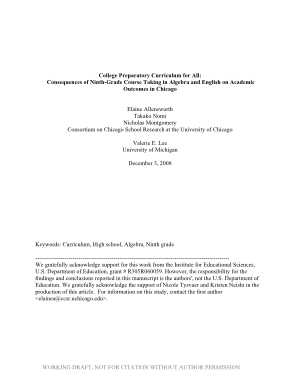1. To what extent did enrollment in ninth-grade college-preparatory courses increase as a result of the policy mandate, and how did the social distribution of course-taking by students’ race, ability level, and disability status change between pre- and post-policy periods?
2. Did students’ academic outcomes improve by taking college-prep instead of remedial classes, and did the effects differ by students’ academic abilities as they began high school?
3. To what extent did the policy affect students’ academic outcomes overall, and how did the effects differ for students entering high school with different abilities?
There is a national movement to universalize the high-school curriculum so that all students graduate prepared for college. Here we evaluate a policy in Chicago that ended remedial classes and mandated college-preparatory coursework for all students. Using an interrupted time-series cohort design with multiple comparisons, we found that the policy reduced inequities in ninth grade coursework by entering ability, race/ethnicity, and special education status. Although more students completed ninth grade with credits in Algebra and English I, failure rates increased, grades declined slightly, test scores did not improve, and students were no more likely to enter college. Although few benefits resulted from universalizing college preparatory coursework among ninth-graders, neither did dropout rates increase. Possible explanations are discussed.
A working paper is a work in progress intended to contribute to current conversations in research, policy, and practice in a timely manner. The findings, interpretations, and conclusions expressed herein are preliminary thoughts solely of the author(s) and shared with permission of the author(s). These preliminary findings, interpretations, and conclusions may change upon further interrogation and collaboration with UChicago Consortium colleagues and other stakeholders in our work.
This paper was published in Educational Evaluation and Policy Analysis, December 2009, Volume 31(4), pages 367 - 391


